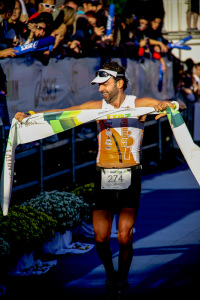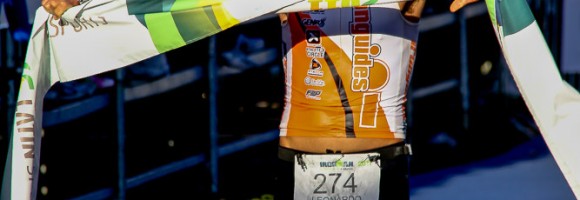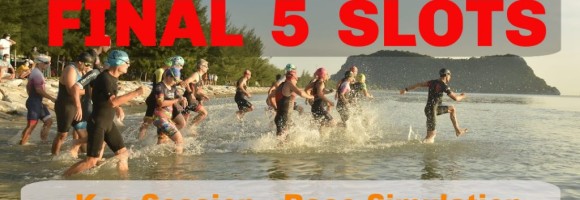It’s said that genius speaks its own language but seldom understands it. If you’ve had the opportunity to spend a little time with geniuses in different fields, you’ve probably noticed something else – they share the ability to master complexity to produce simplicity.
Triathlon remains a pretty small field but we can lay claim to a few technological innovations and feats of endurances that can be called inspired genius. But when it comes to the ability to develop winning athletes, the field narrows to the point that only one man merits the label of genius – Brett Sutton.
I had the good fortune to spend a good deal of the last eight years in almost daily contact with Brett. His achievements leave little doubt that he has a unique ability to generate consistent top-level results in a very complicated sport, working with the finicky personalities of professional endurance athletes no less. A quick summary of his coaching pedigree lists eight ITU world champions, over a hundred ITU World Cup wins, wins at every major triathlon held including the Hawaii Ironman, and more podium finishes than the pages of this article could list. Today a second wave of coaches around the world emulates Brett’s methods in the hunt to develop the next generation of champions in the pro ranks.
My discussions with Brett totally transformed my views on human performance, focused perseverance and human psychology. Although my days as a professional triathlete were over by the time he and I started our dialogue, my understanding of endurance and triathlon training was only beginning. Elsewhere our sport was gravitating to the increasingly generic training protocols that I used to rely on, including zone training, power targets and lactate testing, but Brett’s methods were entirely unorthodox and challenged convention at every step. The more I learned, the more I let go of my quantitative ideas and outdated notions on training and embraced the common sense of his approach.
Imagine – little to no periodization throughout the year, but instead a steady diet of skills acquisition and working on one’s weaknesses. No “key” races and generic tapering formula, but rather a flexible approach that takes into account recent training context. Weekly recovery derived from the structure of carefully designed programs that had athletes training every day, often using a strongly repetitive program. No reference to triathlon’s component sports to train, but rather triathlon-specific techniques to develop skills in each component more relevant to triathlon.
Although professional and Age Group triathlon are two very different sports, there are principles and perspective on training that you can learn and apply to your own training to make it more effective, save time, enhance recovery, all in a more enjoyable, qualitative way. No need to sift through the tea leaves of daily heart rate or power downloads, no need to spend money on expensive gadgets, and no need to plan daily training months in advance.
In this series of articles, we’ll take a look at how we’ve applied some of the principles of professional triathlon training to create a counter-intuitive approach to training we call The Method. By the end of this series, hopefully you’ll come to understand triathlon training from an entirely different, simplified and holistic perspective.

SwimBikeRun
To understand triathlon you need to look at our sport not as the sum of its parts, but as swimbikerun – a single event taking place in changing environments, requiring different skills applied at similar levels of exertion. Training in each component needs to take place in a broader context than single sport training, so when you see someone referring to what swimmers, cyclists or runners do to prepare for a race – tune out! Triathlon takes place under completely different scenarios.
We’ll take a look at specific training for each of triathlon’s components, but here’s a few examples of what I mean. In a triathlon, you’ll rarely ever find calm, flat water. Instead you’re faced with flailing arms, chop and murky water. If you’re a relatively unskilled swimmer, long distance-per-stroke glide phases open you up to “stroke interruption” every time you pause, leading to time-consuming re-acceleration at every stroke. It’s much better to adopt a short, choppy but powerful stroke that minimizes glide and maintains forward momentum with a more rapid arm turnover.
Likewise, contrary to conventional wisdom for cyclists, triathletes benefit from a lower cadence on the bike, not just to preserve fast twitch fibers for the run, but also to make maximum use of training time to generate strength on the relatively limited number of miles we ride. And on the run, it pays to train at a high stride rate (greater than 90 steps per leg per minute) because taking more, smaller steps is a more efficient way to run faster on tired, depleted leg muscles. We’ll take a detailed look at how to we structure training in each component in later articles in the series.
Five Systems
From a general perspective, fitness can be divided into five categories: Aerobic fitness, muscular strength, muscular endurance, flexibility, and body composition. At ironguides, instead of viewing your training as “Zones”, which take into account only your level of aerobic fitness, we refine the above aspects of fitness further to come up with a more triathlon-specific view on training needs.
We call these categories the Five Systems and use them to classify all our training so that we can achieve a more complete training structure that stimulates multiple components of fitness consistently, shifting emphasis to one or the other depending on the time of year, race calendar, individual needs, life circumstance, and so on. Looking at training this way helps you understand how training can be structured to enhance recovery while continuing to train hard everyday.
The Five Systems we use are Strength, Speed, Neuromuscular (or Skill), Tolerance and Endurance. All of these can be combined to various degrees, but by viewing training with these categories in mind and understanding how they relate to one another, you can create a training structure that helps you become “the complete athlete” without ever having to refer to a training zone or power output. With a properly structured plan you can focus your training more specifically and gain aerobic fitness anyway!
You’re so hormonal!
An obscure study from 1995 entitled Blood hormones as markers of training stress and overtraining. (Urhausen A, Gabriel H, Kindermann W. Sports Med. 1995 Oct;20(4):251-76) showed that an athlete’s testosterone/cortisol ratio indicates the physiological strain of his or her training load. To understand why this matters and how you can use this information to create an optimal training structure without falling into the trap of zone training, you need to have a basic understanding of human endocrinology.
Our hormones govern how our body responds to stimuli, including training stimuli. While all training is by and large a “catabolic” process (it breaks your body down through the action of cortisol), if you incorporate short, intense training such as strength work or very fast, very short intervals (which demand high muscle recruitment), you can promote a higher release of testosterone and human growth hormone and support a more “anabolic” training response (a building up of the body). By incorporating Strength and Speed training in your weekly routine at the right times, you can mitigate the effects of more catabolic Endurance and Tolerance sessions, while still using your training time in a sport-specific way.
By categorizing training into Five Systems and understanding how training in those systems affects your endocrine system, you can structure your training to maximize training effort on a daily basis while still permitting day-to-day recovery. While one System rests, another works! In this very basic way, you can design a training program in which you can always train hard.
For example, we like to assign a set of Power Intervals on the bike (such as 10 x 60sec of very high resistance at very low cadence on a spin bike, with equal rest) the day after an athlete has completed an Endurance effort. The anabolic tendency of the interval set mitigates the catabolic nature of the Endurance effort.
Upgrade your skills!
Much of the credit for the incredible performances by single sport athletes can be attributed to the high volume of work they do performing a single or limited range of motions over and over again, which develops extreme efficiencies of movement. As triathletes we don’t have this luxury, so you need to incorporate into your training some form of skill work to really make each session count. Through the use of the right tools or terrain you can do this without impacting the quality of your training and recovery.
For example, instead of heading out the door for 40 minutes in “Zone 1-2”, take a broader view on your run training and incorporate some leg speed training using a treadmill or light downhill gradients. You’ll teach your muscles to fire more rapidly without compromising the workout because you’ll be running faster than on flat ground at the same aerobic intensity. Using the right tools and approach, you can incorporate skills training into almost any session. Swim paddles and pull buoy permit better body position in the water and help develop strength, while a spin bike can help develop your cycling strength.
Keep in mind that if you’re an older athlete, you’ll struggle to acquire new motor skills but that doesn’t mean give up! Instead, you need to train more frequently in the more technical sports (such as swimming) to maintain current skills.
Common sense recovery
Age Group athletes face particular demands that mean life often interferes with our best-laid plans. Instead of taking days off when the schedule says, why not take them when life demands it due to work, family or other commitments or unforeseen events? Training this way ensures consistency and frees up time when it’s most needed – knowing you have trained your best in recent sessions means you’re less likely to worry about missing the odd session due to other obligations.
Cyclical periodization and repetition
The basis of traditional training periodization was founded decades ago when scientific knowledge was far from complete and athletes’ workloads and demands were much lower than today. More recently, progress in sport science has reinforced the contradictions between traditional periodization and the successful experiences of prominent coaches and athletes using a more cyclical approach. The Method stresses repetition and a cyclic approach to training to concurrently develop motor skills, fitness and mental strength.
A cyclic training approach enables you to continually train all aspects of fitness while emphasizing specific components according to your needs, race calendar and other factors. As the race season draws near, you can begin to emphasize more race-specific factors. For example, our Olympic distance and Ironman athletes train in very similar ways for much of the year, but as Ironman approaches our long course athletes pick up the volume. Rather than having fatigued themselves with high mileage and unspecific training all winter long, they arrive at the final race preparation phase with a strong foundation and arsenal of skills.
And, rather than planning training sessions months in advance, we use a more repetitive training plan based on a weekly routine that you repeat. Not only does this remove the guesswork from setting your weekly routine, it also means you use your training sessions as performance benchmarks. By performing the same training session for several weeks, you can also better develop your intuitive feedback skills and learn to “ride out the rough patches” in your training, coming to better understand the effects of recent changes elsewhere, such as in your sleep, diet or stress patterns. Over time you also learn to better gauge and interpret fatigue levels so that you can better predict when you need time off, and when it’s worthwhile continuing a session.
* * *
Combined with a few simple intensity guidelines no more complicated than “easy”, “moderate”, “hard” and “all out”, you can reach new levels of triathlon performance by training more consistently, with less reliance on gadgets to guide your training, while freeing up time and putting the joy back in training.
Heresy!
–
Train with ironguides!
Personalized Online Coaching: Starting at USD190/month
Monthly Training plans (for all levels, or focused on one discipline): Only USD39/months
Event based training plans:
Sprint Distance (USD45 for 8-week plan)
Olympic Distance (USD65 for 12 week plan)
Half Ironman (R$95 for 16-week plan)
Ironman (USD145 for 20-week plan)
X-Terra (USD65 for 12-week plan)
Running Plans (10k, 21k and 42k – starting at USD40)



















Recent Comments